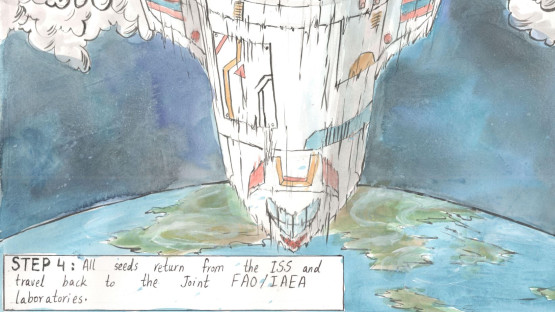More than 70 young artists around the world submitted designs for the Seeds in Space Comic Book Contest held by the IAEA and Food and Agriculture Organization of the United Nations (FAO), aimed at inspiring the next generation of experts in nuclear science and technology. The winner is 17-year-old Seemab Fatima from Pakistan, whose ink and watercolour artwork will serve as inspiration to create a comic book revealing how cosmic radiation and the harsh conditions of space could help develop better crops for food security on Earth.
Artists, aged between 14 and 18, depicted the journey of the IAEA and FAO crop seeds sent to the International Space Station (ISS), part of an IAEA and FAO research project on breeding new plant varieties that can withstand the effects of climate change and help farmers provide sufficient food.
“This first-of-a-kind project gave us an opportunity to engage youth in discovering how nuclear techniques provide exciting contributions to astrobiology and help breed new varieties of plants adapted to climate change,” said Sophie Boutaud de la Combe, Director of the IAEA’s Office of Public Information and Communication. “We received many fantastic drawings, and the decision was not easy. Seemab’s visual narration of the 'seeds in space story' is very inspiring and beautifully executed.”
Participants used a range of digital and traditional mediums to draw up to six steps of the seeds’ journey, including: seeds preparation at the Joint FAO/IAEA Centre of Nuclear Techniques in Food and Agriculture laboratories in Seibersdorf, Austria; launch of the seeds into space and docking at the ISS; exposure to cosmic radiation, antigravity and extreme temperatures inside and outside the ISS; splashdown; analysis and growth; and the potential results.
“Three IAEA and FAO experts in plant breeding and communications judged the artworks anonymously based on the representation of nuclear science, originality, creativity and design. The vote for the winner was unanimous,” said Clara Velez Fraga, FAO Chief of Outreach and Promotions.
“The potential of space exploration is immense and by entering the competition, and combining my love for art and space, I learned about the IAEA’s and FAO’s work to address hunger on Earth,” said contest winner Fatima.
The artwork of the ten finalists, including the winning entry, can be seen in the virtual gallery.
- Seemab Fatima, 17
- Airi T. Takada, 16
- Shruti Prahlad Yadav, 14
- Christine Margarette M. Pabelonio, 15
- Nur Emily Fazli Low, 17
- Puteri Khairina Binti Lin Chap Akang, 14
- Kaella Caliwag, 15
- Kyle Sander S. Magante, 16
- Shelby Gayle M. Torres, 18
- Zhu Yushi, 17







